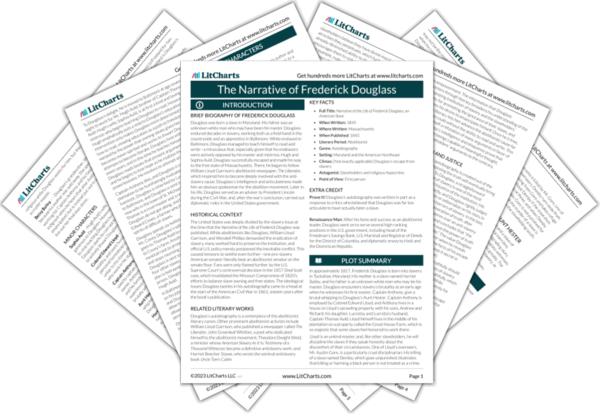The Self-Destructive Hypocrisy of Christian Slaveholders
Narrative of the Life of Frederick Douglass is full of blistering critiques of slave owners who feign religious piety. Douglass’s experience often shows that the white southerners who participate most zealously in religious activities are often the same ones who treat slaves most inhumanely. These reprehensible people are quick to condemn slaves for the slightest violations of biblical principles, but are all too willing to twist scripture into justifying their own horrifyingly irreligious acts. For…
read analysis of The Self-Destructive Hypocrisy of Christian SlaveholdersKnowledge and Ignorance
Douglass writes, “I have found that, to make a contented slave, it is necessary to make a thoughtless one. It is necessary to darken his moral and mental vision, and, as far as possible, to annihilate the power of reason. He must be able to detect no inconsistencies in slavery; he must be made to feel that slavery is right; and he can be brought to that only when he ceases to be a man.”…
read analysis of Knowledge and IgnoranceTruth and Justice
Douglass’s autobiography is created out of the belief that exposing the truth will eventually bring about justice. To Douglass, a straightforward depiction of the true nature of slavery is one of the most effective ways to combat the injustice of the institution. His story is delivered matter-of-factly, and Douglass rightly judges that he doesn’t need to embellish or editorialize on his story in order to persuade readers of the horrors of slavery. In the text…
read analysis of Truth and Justice
The Inexpressibility of Enslavement
Douglass’s commentary throughout the book suggests that someone who has the fortune never to be enslaved can never truly understand slavery. The hardship of slavery is inexpressible. For example, when recounting his escape, Douglass writes, “I say, let him be placed in this most trying situation,—the situation in which I was placed,—then, and not till then, will he fully appreciate the hardships of, and know how to sympathize with, the toil-worn and whip-scarred fugitive slave.”…
read analysis of The Inexpressibility of EnslavementFellowship
Slave owners do everything they can to undermine any basic ties of kinship that could unite their slaves. Families are broken up; much to Douglass’s dismay, he barely gets to know his mother, Harriet Bailey, and his siblings are utterly alienated from him. However, in spite of their masters’ cruel designs, slaves develop profound attachments to one another: writes Douglass, “I was…somewhat indebted to the society of my fellow-slaves…I loved them with a love…
read analysis of Fellowship






